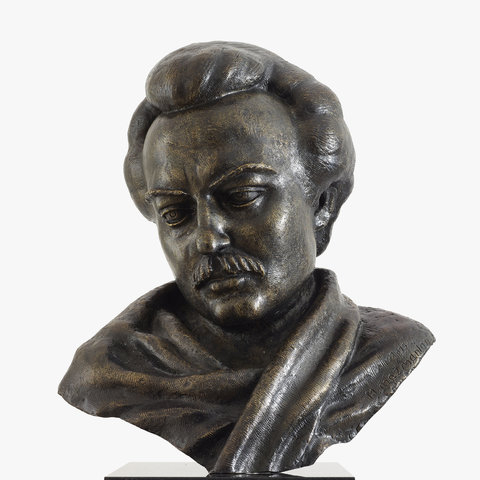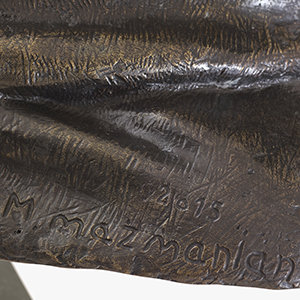Mkrtich Mazmanian was born in 1944 in Gyumri, Armenia1. He displayed a talent for artistic creation early on in his life, often producing illustrations. He completed his first sculpture at the age...





Mkrtich Mazmanian was born in 1944 in Gyumri, Armenia1. He displayed a talent for artistic creation early on in his life, often producing illustrations. He completed his first sculpture at the age...
Mkrtich Mazmanian was born in 1944 in Gyumri, Armenia1. He displayed a talent for artistic creation early on in his life, often producing illustrations. He completed his first sculpture at the age of just five 2. Mazmanian expressed his gradual preference for sculpture over illustration saying, “I [have always] had a huge craving for drawing. In the years that followed, my instructors emphasized that I had a talent creating artwork rich in dimensions and perspective”3.
In 1951, Mazmanian continued his artistic journey at the Gyumri Art School. Later he attended Mercurov Art School, in Gyumri and the Terlemezian Art College, in Yerevan. In 1965, he pursued a Master’s degree at the National Higher Art Institute of Tallinn, in Estonia, specializing in sculpture, graduating in 1975.
One of the most iconic pieces of Mazmanian’s work is his obelisks, which made their inaugural debut at the Gyumri airport in 1979. Unfortunately, these obelisks witnessed the Spitak earthquake which hit Armenia 4 in 1988. Fortunately, Mazmanian’s works survived the disaster, establishing his art as a symbol of resilience and easing his way into the Union of Artists of the Republic of Armenia. He was recognized as a member of the union, and as a pivotal figure within the Armenian artistic community.
It was only until 1990 that Mazmanian’s institutional recognition reached the global stage. He became a member of the International Association of Art (IAA), an UNESCO artistic institution. The following year, against the backdrop of the crumbling Armenian Soviet Socialist Republic, the Mazmanian took a bold step into a new chapter of his artistic journey, relocating to Beirut, Lebanon. Despite the nation being torn by war, Mazmanian's repertoire and prestige soared in the Middle East.
A significant marker of his achievement is the 1999 commission to create the official sculpture of Cardinal Nasrallah Sfeir, Patriarch Emeritus of the Antioch Church. The sculpture became a testament to Mazmanian’s ability to capture the essence of revered figures. This marked the beginning of a fruitful career in Lebanon, where Mazmanian designed and constructed the official monumental sculptures of various Lebanese heads of state, including President Michel Suleiman, President Camille Chamoun, and Prime Ministers: Elias Skaff, Saeb Salam, and Rafic Hariri. Another important Lebanese immortalized by Mazmanian was renowned 20th century author Gibran Khalil Gibran, whose bronze bust sits in the Ramzi and Saeeda Dalloul Art Foundation (DAF). He produced much of these works in quite a memetic manner, influenced by fellow Soviet sculptor Sergey Merkurov, who also sculpted in this realist manner.
Another important aspect of Mazmanian’s sculptures of public figures, apart from Gibran Khalil Gibran, N.D. is their existence as public works; they can be viewed by everyone within a larger architectural structure or environment. In an interview, Mazmanian claimed, “I think for every sculptor, it is a dream to have a sculpture in public spaces, as it is a creative challenge to connect the monumental sculpture with the architecture of its environment” 5.
One such architectural landscape was the Komitas Pantheon6 in Yerevan Armenia, where Mazmanian mounted his 2013 tribute to beloved Armenian actor, Sos Sargsyan. This sculpture, however, was an example of a public monument of a public figure produced in a less memetic manner. Mazmanian’s metal sculpture portrays an exact figurative representation of the actor’s head, however, the remaining body is carved out of different abstract cylindrical forms that appear like bamboo shoots.
In general, Mazmanian is concerned with the human anatomy’s allegorical relationship with nature. This is demonstrated in his sculptural works depicting female figures finished with a rough, scaly texture similar to a tree trunk. This is apparent in his 1995 bronze work, Prayer7. Similarly, Mazmanian has also created other works revealing a finished texture similar to seashells in works like the undated bronze piece Shell 8. Mazmanian emphasized the relationship between nature and the female body.
Semi-abstraction is definitive of much of Mazmanian’s work seen in pieces such as Hera, 2013,9 or Narcis, 202310 which abstract the female form, highlighting and exaggerating the tightness of their waists and their hourglass figure. In both these works, you see women’s arms and hair abstracted into a cascading single sheet.
Mazmanian portrays the anatomical female figure in a rather curvilinear formation. For instance, in his sculpture Salome, 2023 he exaggerates the female’s round buttocks, in Divine Pearl, 2010, he accentuates the female’s voluptuous breasts and narrow waist, while in The Dance Salome, 2023, he twists the female subject almost into a series of hoops, accentuating her fluidity.
The human form, be it a female figure or the bust of a public figure, is central to Mazmanian’s oeuvre. The torch of the Mazmanian family artistic legacy was passed to Mazmanian's daughter 11, Zara. In 2009, she established Esquisse Gallery, a platform to showcase both emerging Armenian talent and the works of her accomplished father 12. The Gallery works both in Yerevan and in Beirut, embodying the twin Armenian and Lebanese landscapes that have housed Mazmanian’s work, and provided the ideal environment for it to flourish.
Edited by Wafa Roz & Elsie Labban
Notes:
1 “Biography,” Esquisse Gallery, accessed December 18, 2023, https://esquissegallery.com/
2 Lilly Torosyan, “Sculpting the Big Apple: Artist Mkrtich Mazmanian’s Debut in Major NYC Exhibition,” The Armenian Weekly, April 21, 2017, armenianweekly.com
3 Lilly Torosyan, “Sculpting the Big Apple: Artist Mkrtich Mazmanian’s Debut in Major NYC Exhibition,” The Armenian Weekly, April 21, 2017, armenianweekly.com
4 “The Spitak Earthquake,” National Centers for Environmental Information (NCEI), April 7, 2023, https://www.ncei.noaa.gov/prod
5 Lilly Torosyan, “Sculpting the Big Apple: Artist Mkrtich Mazmanian’s Debut in Major NYC Exhibition,” The Armenian Weekly, April 21, 2017, https://armenianweekly.com
6 “The Memorial of Sargsyan SOS (Սոս Սարգսյան ) Buried at Yerevan’s Komitas Pantheon Cemetery,” The memorial of Sargsyan Sos (Սոս Սարգսյան ) buried at Yerevan’s Komitas Pantheon cemetery, accessed January 2, 2024, https://hush.am/index.php
7 Mkrtich Mazmanian | Prayer (1995) | artsy, accessed December 18, 2023, www.artsy.net/artwork/
8 “Shell,” Armenia Art Fair, accessed January 2, 2024, https://armeniaartfair.com
9 Mkrtich Mazmanian | Hera (2013) | artsy, accessed December 18, 2023, https://www.artsy.net/artwork
10 “Mkrtich Mazmanian,” Facebook, accessed December 18, 2023, https://www.facebook.com
11 Red Dot Miami 2017 - Interview with Zara Mazmanian Esquisse Gallery, YouTube (YouTube, 2018),
Bibliography
“About Us.” Esquisse Gallery. Accessed December 18, 2023. https://esquissegallery.com/
Archive (Esquisse Gallery). Accessed December 19, 2023. https://archive.ph/
“Biography.” Esquisse Gallery. Accessed December 18, 2023. https://esquissegallery.com
“Les Dames de Beyrouth.” Lebtivity. Accessed December 18, 2023. https://www.lebtivity.com
“Mazmanian.” Mazmanian @ artavita. Accessed December 18, 2023. https://www.artavita.com
“The Memorial of Sargsyan SOS (Սոս Սարգսյան ) Buried at Yerevan’s Komitas Pantheon Cemetery.” The memorial of Sargsyan Sos (Սոս Սարգսյան ) buried at Yerevan’s Komitas Pantheon cemetery. Accessed January 2, 2024. https://hush.am/index.php
Mkrtich Mazmanian | Hera (2013) | artsy. Accessed December 18, 2023. https://www.artsy.net/artwork/
Mkrtich Mazmanian | Prayer (1995) | artsy. Accessed December 18, 2023. https://www.artsy.net/artwork
“Mkrtich Mazmanian.” Facebook. Accessed December 18, 2023. https://www.facebook.com
Pearce, Michael, Adam Szymanski, and Benjamin Blake Evemy. “Divine Pearl.” MutualArt, December 13, 2023. https://www.mutualart.com
Pearce, Michael, Adam Szymanski, and Benjamin Blake Evemy. “Woman.” MutualArt, December 13, 2023. https://www.mutualart.com
Red Dot Miami 2017 - Interview with Zara Mazmanian Esquisse Gallery. YouTube. YouTube, 2018.
“Shell.” Armenia Art Fair. Accessed January 2, 2024. https://armeniaartfair.com
“The Spitak Earthquake.” National Centers for Environmental Information (NCEI), April 7, 2023. www.ncei.noaa.gov
Torosyan, Lilly. “Sculpting the Big Apple: Artist Mkrtich Mazmanian’s Debut in Major NYC Exhibition.” The Armenian Weekly, April 21, 2017. armenianweekly.com
Selected Solo Exhibitions
80th Anniversary Exhibition of Sculptor Mkrtich Mazmanian, Grand Hotel Yerevan, Yerevan, Armenia
New York City, New York, United States of America
Les Dames de Beyrouth, Le Gray Hotel, Beirut, Lebanon
Selected Group Exhibitions
Carrousell Du Louvre, Louvre, Paris, France
Hivernales De Paris, Paris, France
Le Grey Hotel, Beirut, Lebanon
Ministry of Tourism, Beirut, Lebanon
Art Center, Manama, Bahrain
Riviera Hotel Beirut, Beirut, Lebanon
La Cigale Beirut, Lebanon
Gulbenkian Centre, Beirut, Lebanon
Art Centre of Painters, Yerevan, Armenia
Opera Exhibition Hall, Talin, Estonia
Awards and Honors
Honorary guest, BIAF (Beirut International Art Festival), Beirut, Lebanon
Best Sculpture Award, Art Expo New York, New York, United States of America
Affiliations & Memberships
Union of Artists of the Republic of Armenia
International Association of Art
Collections
The Ramzi and Saeda Dalloul Art Foundation, Beirut, Lebanon
Museum of Cilicia, Antelias, Lebanon
Nicolas Ibrahim Sursock Museum, Beirut, Lebanon
Join us in our endless discovery of modern and contemporary Arab art
Get updates from DAF
Follow Artists
Save your favourite Artworks
Share your perspectives on Artworks
Be part of our community
It's Free!
We value your privacy
TermsCookiesPrivacy Policies
Get updates from DAF
Follow Artists
Save your favourite Artworks
Share your perspectives on Artworks
Be part of our community
It's Free!
We value your privacy
TermsCookiesPrivacy Policies
Get updates from DAF
Follow Artists
Save your favourite Artworks
Share your perspectives on Artworks
Be part of our community
It's Free!
We value your privacy
TermsCookiesPrivacy Policies
If you have entered your email to become a member of the Dalloul Art Foundation, please click the button below to confirm your email and agree to our Terms, Cookie & Privacy policies.
We value your privacy, see how
Get updates from DAF
Follow Artists
Save your favourite Artworks
Share your perspectives on Artworks
Be part of our community
It's Free!
We value your privacy
TermsCookiesPrivacy Policies